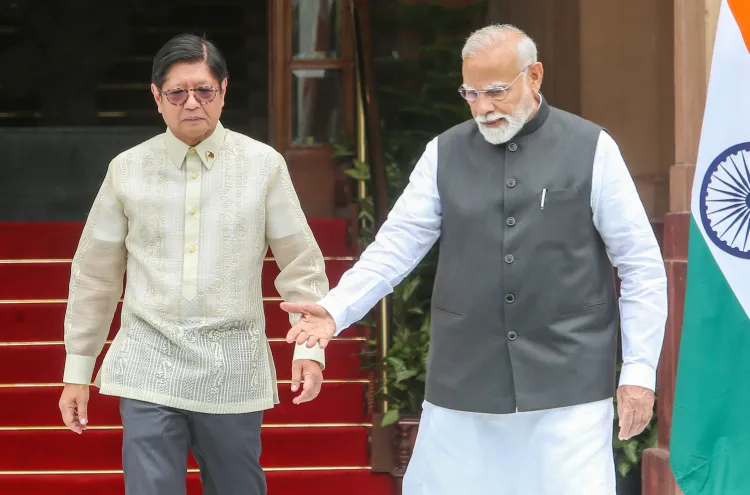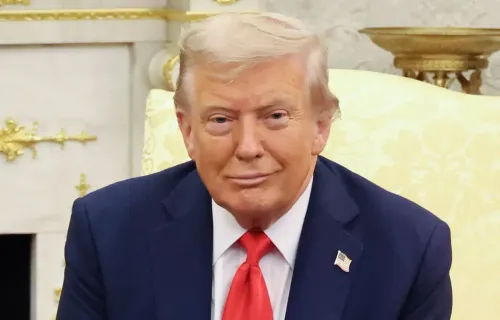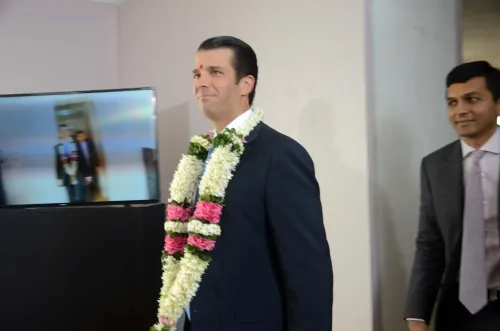What Changes Are Emerging in the India-Philippines Strategic Partnership and the South China Sea?

Synopsis
Key Takeaways
- India and the Philippines have established a new Strategic Partnership.
- Joint naval exercises were conducted in the South China Sea.
- Visa-free travel was announced to enhance tourism.
- Both nations agreed on a 2025-2029 Plan of Action for collaboration.
- India aims to bolster its position as a maritime power in the region.
New Delhi/Manila: Ferdinand 'Bongbong' Romualdez Marcos Jr., the 17th President of the Philippines, undertook a significant State Visit to India from August 4-8. This visit not only marked the formation of a Strategic Partnership between India and the Philippines but also celebrated the 75th anniversary of diplomatic relations between the two countries. Accompanying President Marcos were 14 ministers, high-ranking officials, and a substantial business delegation.
During this historic visit, the navies of India and the Philippines conducted joint exercises in the South China Sea (SCS) for the first time, emphasizing the importance of security cooperation.
The timing of President Marcos' visit coincided with India's efforts to forge partnerships in the SCS, highlighting India's vested interest in ensuring maritime safety and security for its trade routes that pass through these waters. The SCS is a vital shipping lane, facilitating approximately $5 trillion in annual maritime commerce.
As part of the discussions, both nations adopted a 2025-2029 Plan of Action under the enhanced Strategic Partnership, agreeing to collaborate across various sectors, including politics, defense, security, economics, trade, investment, and technology.
During bilateral talks, President Marcos expressed a desire to strengthen defense ties, including potential purchases of Indian defense equipment. The Philippines, an archipelago of about 7,600 islands, follows an archipelagic defense strategy to safeguard its extensive maritime resources.
In a bid to bolster tourism and cultural exchanges, President Marcos announced a visa waiver for Indian nationals visiting the Philippines. Prime Minister Narendra Modi reciprocated by offering free e-visas for Filipino tourists, and direct flights from Delhi to Manila are set to launch on October 1.
It is noteworthy that from July 30 to August 4, the Indian and Philippine navies participated in joint exercises in the West Philippine Sea.
General Romeo Saturnino Brawner Jr., the 60th Chief of Staff of the Philippine Armed Forces, mentioned that the concept of conducting joint exercises within the Philippine Exclusive Economic Zone originated during his visit to New Delhi in March.
The Philippines has expressed concerns that even a minor incident in the SCS could escalate into a full-scale conflict with China.
The Philippine Armed Forces (PAF) is keen to collaborate with the Indian Armed Forces, which share similar values. The PAF is satisfied with the Indo-Russian BrahMos supersonic cruise missile system, enhancing its coastal defense capabilities amid rising tensions with China, and is interested in acquiring additional military equipment from India.
China asserts claims over nearly the entire SCS, overlapping with the maritime zones of Brunei, Indonesia, Malaysia, the Philippines, and Vietnam. A July 2016 ruling by an international arbitral tribunal dismissed China's extensive claims under international law, siding with the Philippines. China has rejected this ruling, which was a significant milestone in the legal framework for maritime dispute resolution under the UNCLOS.
India's stance on SCS disputes has evolved from cautious neutrality to a more proactive approach driven by its Act East policy and Indo-Pacific vision. India views the SCS as a global common area, supporting freedom of navigation and legitimate commerce through these waters. The SCS has served as a crucial Sea-Lane of Communication (SLOC) for over 1,500 years, with historical evidence of Indian traders navigating these waters. Undoubtedly, the SCS remains within India's maritime interests and strategic focus.
Although India is not a claimant state, it has vital interests in the SCS due to its significant trade routes. As a leading maritime power in the region, India is increasingly engaged in the South China Sea, concerned about the ongoing territorial disputes among ASEAN countries, especially given the tensions with China. India's efforts aim to establish itself as a responsible maritime force to stabilize the area.
Approximately 55% of India's trade transits through the SCS and the Malacca Strait, making this region essential for commerce with the Indo-Pacific and beyond. In its strategic calculations, India's naval presence in the SCS complicates China's position, reinforcing the sovereignty of both India and the Philippines. The growing ties between New Delhi and Manila signify India's emergence as a trusted strategic ally for the Philippines.
(The author is an expert in South Asia and Eurasia and previously worked at the Manohar Parrikar Institute for Defence Studies and Analyses. The views expressed are personal.)









